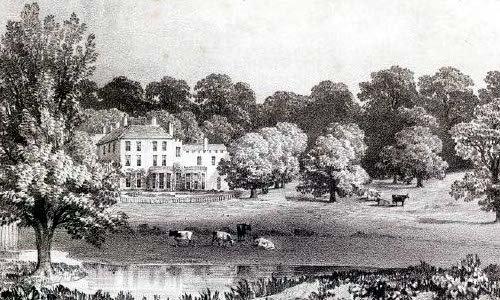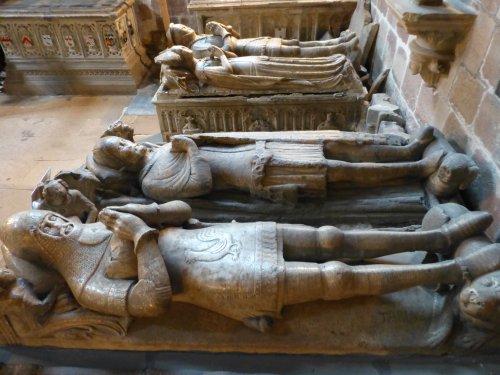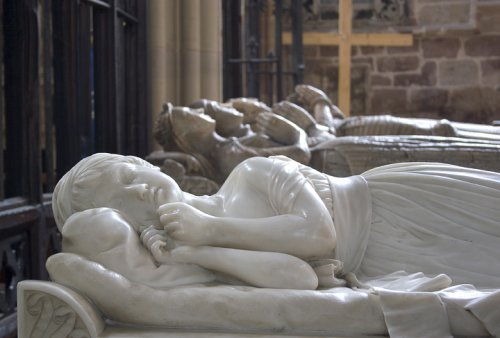Lady Cockayne’s Walk, or originally The Long Walk, was an avenue of mature trees that ran parallel to Hall Lane/Green Road and was supposed to be the sight of many ghostly midnight appearances in later years.
The history of the hall starts with the Cockayne family who are first recorded in Ashbourne in 1150 – they were a branch of a family that lived at Hemingham Castle near Alresford in Essex from the reign of William the Conqueror having come over from Normandy with the De Veres at the time of the conquest. They may have built the Hall or taken over an existing structure when they were put in charge of the Manor of Ashbourne which they held for the next 500 years through the reigns of 22 monarchs.
Drawings of 1547 show a rambling gabled timber framed range of buildings built around a courtyard with a castellated brick gatehouse and possibly a ‘great hall’. This had clearly grown over the years and by the Hearth Tax returns of 1662 the house had 21 chimneys making it one of the largest private homes in Derbyshire.
The Boothby family took over the estate in 1671. They made alterations and additions, many on the instructions of Sir Brooke Boothby, 4th Bt., in the 1780s. James Pilkington writing in 1789 in A view of the present state of Derbyshire: commented that he ‘has made and is still making considerable improvements in the house and the ground about it’. This included diverting the Henmore and the road to Wirksworth from passing in front of the house to passing to the rear.
Glover, in his history of Derbyshire in 1833 gives the following account of the building. “The present mansion has been erected at different periods, and is not possessed externally of any architectural beauties. The ancient part is castellated, and the later additions to it are in the modern style of architecture.”
After Sir William Boothby’s death in 1846 the hall was sold and within a year it had been split into 46 different lots. Before 1887 it had become a hotel and later the property of the local authority. The west block was reduced from three stories to two.
The Hall was certainly rebuilt a number of times during the Cockayne family occupation. It is illustrated on the map of 1547. Many generations took great trouble in their wills to ensure the property would never be sold or ‘lost’ to the family and that fixtures, pictures etc. would never be removed. Unfortunately this failed when the poet Sir Aston Cockayne (1607 – 1683) who, as a Catholic and supporter of King Charles I during the Civil War, had managed to end up in Marshalsea Prison for debt – much of it due to his own extravagance and much of the debt owed to other members of the Cockayne family. He ended his days living in lodgings in Derby having joined with his son in selling Ashbourne Hall and other estates in 1671.
Sir William Boothby of Broadlow Ash purchased the Hall and much of the estate in 1671 and his family lived there until the mid-19th century. The hall was considerably altered and additional land acquired to add to the deer park which had been enclosed by Sir Thomas Cockayne prior to 1537. This was landscaped and the brook widened to form fish ponds – these were again developed into a boating lake with ornamental islands and other follies by the later Boothby’s.
The Boothby’s were ‘away in the hills’ when Prince Charles Edward Stuart (Bonnie Prince Charlie) called to stay for the night on his way to Derby in 1745 following the declaration in Ashbourne market place of his father as King. The Scottish troops camped in the park and for many years an old Claymore was kept in the house as a reminder of the visit.
Sir Brooke Boothby, the 6th Baronet, was part of the intellectual and literary circle which included Anna Seward and Erasmus Darwin and other members of the Lunar Society. He married in 1784 and leased the hall from his father, whose extravagance had forced him to live elsewhere. He then began rebuilding it in 1785 using his wife's dowry to remodel the parkland, purchase rare plants and obtain works of art including the famous portrait of Boothby by Joseph Wright of Derby.
The hall was rebuilt in a plain Georgian style by Thomas Gardner of Uttoxeter. Originally 3 storeys high and 4 x 5 bays wide with a later 3 bay extension added to the North, the extension was rebuilt in 1851 to give an 11 bay West front. The irregular outline is believed to reflect the foundations of the old hall. The building then acquired canted bays to the South and castellations, the latter of which were subsequently removed.
The land in front of the Hall that Boothby had incorporated into the Hall gardens meant the road to Wirksworth had to be closed and the route diverted. The ornamental stable block was constructed in the 1780’s and survives as ‘Cockayne Mews’. It would be 1922 before Cockayne Avenue would be pushed across the front of the Hall and the route reinstated for public use.
Brooke Boothby was extravagant, emotional and self-indulgence; his only daughter Penelope was born in 1785 and died at the age of five. Boothby never recovered from the emotional loss and financially crippled by his excesses he left Ashbourne never to return; after roaming the continent he finally settled in diminished circumstances in Boulogne in 1815 and died there in 1824.
Ashbourne Hall was leased in 1814 (parish records show that in 1817 Sir Richard Arkwright's grandson, also Richard, was living there) and in 1846 the house and estate was put up for auction in London. Bidding stopped at £27,950 (£2.1 million today) but this was below the reserve and the property remained empty and unoccupied until subsequently bought by an Ashbourne solicitor John Fox, who within months had broken up and sold off the estate in separate lots.
After being briefly owned by a Roman Catholic priest who wanted to turn the Hall into a seminary it was bought by Capt R. N Holland RN only to be sold again a decade later to Sir John Bent a surgeon. On his death it passed to Mr R H Frank whose widow, having beaten off attempts to play Shrovetide Football in the grounds, sold in 1898 to Mr W. H. Holland.
In 1902 it opened as a hotel and then began a long decline in which various parts were sold off and the road across the south front was reinstated, cutting off the park, some of which became council housing (Park Estate) and a public open space. The old Cockayne family portraits were also auctioned off at this time and despite subsequent attempts by Lord Cullen’s father to recover them for the family they could not be traced. A portrait of Sir Aston Cockayne was found at Queen Elizabeth’s Grammar School in 2004 but history repeated itself and this was auctioned off in London by the Old Trust and its whereabouts are now unknown.
By 1948 a large part of the building had been dismantled and the rest converted to flats, Local Authority housing was built over much of the ornamental gardens and Parkside School built on the site of the kitchen gardens. The Town Library subsequently occupied part of the ground floor on the south front, with a corn merchant, printers and the Masons occupying other parts of the decaying building. The Library has now moved to a new building in Compton. Part of the Hall has now been refurbished and can be rented as self-catering accommodation for tourists. A 40 acre remnant of the park survives in the Memorial Gardens, recreation grounds and fishponds which now form Ashbourne Park.
The Hall had a private chapel dedicated to St Mary near the gates dating from before 1447 which allegedly had a fresco around the walls which read;
‘Do anye manner off Slaverie, rather than selle thye Patrimonie,
But rather selle they Patrimonie, than borrowe monie on Usurie’
This building was eventually turned into a malthouse and the legend copied onto a heavy brass plate and placed over the fireplace in the entrance hall. The old Chapel was demolished when the Hall was rebuilt around 1785.
In 1833 Glover also described the interior of the Hall. ‘The interior of the house is also fitted up and disposed with taste and elegance. The library, comprising upwards of six thousand volumes, is a choice collection of classic and polite literature. The principal rooms are ornamented by a valuable collection of paintings by the first masters, many of them being from the collection of his Royal Highness, the late Duke of York, who was a particular friend of the late Sir Brooke Boothby, Bt. In the Hall: a full length portrait of Sir Brooke Boothby, by Wright of Derby; his Majesty, George the Third, at full length, and several other paintings.’
Glover then details the paintings in the Dining-room and the Drawing-room. There are portraits by Sir Joshua Reynolds, Fuseli, Hoppner and other noted artists of the day. Reynolds, Fuseli and Hoppner were frequent visitors to Ashbourne. (Hoppner painted three of the daughters of the Beresford family of Compton.)
The Cockayne family were effectively 'Lords of the Manor' from 1340's to 1671. Their tombs in St Oswald's church form one of the finest family collections in the County and Country.
The Boothby family bought Ashbourne Hall in 1671. They landscaped the Park substantially, including diverting the Henmore and closing the Wirksworth road. The tomb of Penelope Boothby in St Oswald's church is renown.
In 1745 Bonnie Prince Charlie declared his father to be King James III in Ashbourne Market Place. His troops were billeted in Ashbourne Park.












